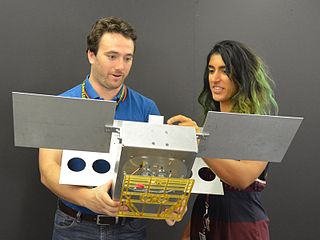
Joseph Rudyard Kipling was an English novelist, short-story writer, poet, and journalist. He was born in British India, which inspired much of his work.

Stainless steel, also known as inox, corrosion-resistant steel (CRES) and rustless steel, is an alloy of iron that is resistant to rusting and corrosion. It contains at least 10.5% chromium and usually nickel, and may also contain other elements, such as carbon, to obtain the desired properties. Stainless steel's resistance to corrosion results from the chromium, which forms a passive film that can protect the material and self-heal in the presence of oxygen.

Engineers, as practitioners of engineering, are professionals who invent, design, analyze, build and test machines, complex systems, structures, gadgets and materials to fulfill functional objectives and requirements while considering the limitations imposed by practicality, regulation, safety and cost. The word engineer is derived from the Latin words ingeniare and ingenium ("cleverness"). The foundational qualifications of a licensed professional engineer typically include a four-year bachelor's degree in an engineering discipline, or in some jurisdictions, a master's degree in an engineering discipline plus four to six years of peer-reviewed professional practice and passage of engineering board examinations.

Polytechnique Montréal is a public research university affiliated with the Université de Montréal in Montreal, Quebec, Canada. In English it may be referred to as "Montreal Polytechnic", but is more often referred to by its French name. The school offers graduate and postgraduate training, and is very active in research. Following tradition, new Bachelors of Engineering (B.Eng) graduating from Polytechnique Montréal receive an Iron Ring, during the Canadian Ritual of the Calling of an Engineer ceremony.

The Order of the Engineer is an association for graduate and professional engineers in the United States that emphasizes pride and responsibility in the engineering profession. It was inspired by the success of the Ritual of the Calling of an Engineer, a similar and much older Canadian ceremony, and has 245 active links across the United States.

The Quebec Bridge is a road, rail, and pedestrian bridge across the lower Saint Lawrence River between Sainte-Foy and Lévis, in Quebec, Canada. The project failed twice during its construction, in 1907 and 1916, at the cost of 88 lives and additional people injured. It took more than 30 years to complete and eventually opened in 1919.
The Leuchter report is a pseudoscientific document authored by American execution technician Fred A. Leuchter, who was commissioned by Ernst Zündel to defend him at his trial in Canada for distributing Holocaust denial material. Leuchter compiled the report in 1988 with the intention of investigating the feasibility of mass homicidal gassings at Nazi extermination camps, specifically at Auschwitz. He traveled to the camp, collected multiple pieces of brick from the remains of the crematoria and gas chambers, brought them back to the United States, and submitted them for chemical analysis. At the trial, Leuchter was called upon to defend the report in the capacity of an expert witness; however, during the trial, the court ruled that he had neither the qualifications nor experience to act as such.
The Ritual of the Calling of an Engineer is a private ritual, authored by Rudyard Kipling, in which students about to graduate from an engineering program at a university in Canada are permitted to participate. Participation may also be permitted for Canadian professional engineers and registered engineers-in-training who received training elsewhere. The ritual is administered by a body called The Corporation of the Seven Wardens. As part of the ritual each participant is conferred the Iron Ring.

The little finger, or pinkie, also known as the baby finger, fifth digit, or pinky finger, is the most ulnar and smallest digit of the human hand, and next to the ring finger.

Henry Petroski was an American engineer specializing in failure analysis. A professor both of civil engineering and history at Duke University, he was also a prolific author. Petroski has written over a dozen books – beginning with To Engineer is Human: The Role of Failure in Successful Design (1985) and including a number of titles detailing the industrial design history of common, everyday objects, such as pencils, paper clips, toothpicks, and silverware. His first book was made into the film When Engineering Fails. He was a frequent lecturer and a columnist for the magazines American Scientist and Prism.

Herbert Edward Terrick Haultain was a Canadian engineer and inventor.

The McMaster Faculty of Engineering is a faculty located at McMaster University in Hamilton, Ontario. The faculty was established in 1958 and was the first engineering program to developed problem-based learning curriculum. It currently has seven departments in chemical engineering, civil engineering, computing and software, electrical and computer engineering, engineering physics, material science and engineering and mechanical engineering. The faculty offers bachelors, masters, and doctoral degrees.
Engineering traditions in Canada are diverse. Many of the traditions are practised at the engineering departments of Canadian universities, where student organisations continue to practise traditions started by other engineers in previous years.
Engineering ethics is the field of system of moral principles that apply to the practice of engineering. The field examines and sets the obligations by engineers to society, to their clients, and to the profession. As a scholarly discipline, it is closely related to subjects such as the philosophy of science, the philosophy of engineering, and the ethics of technology.

The Engineer's Ring is a ring worn by members of the United States Order of the Engineer, a fellowship of engineers who must be a certified Professional Engineer or graduated from an accredited engineering program. The ring is usually a stainless steel band worn on the little finger of the dominant hand. This is so that it makes contact with all work done by the engineer. Rings used to be cast in iron in the most unattractive and simple form to show the nature of work. The ring is symbolic of the oath taken by the wearer, and symbolizes the unity of the profession in its goal of benefitting mankind. The stainless steel from which the ring is made depicts the strength of the profession.

A pinky ring is any ring worn on the pinky, or little finger, of either hand. A pinky ring may have special significance conferred by the wearer's office or professional association, but may also may be worn purely for fashion. Signet rings, which hold their own meaning, are often worn on the pinky.

Santería, also known as Regla de Ocha, Regla Lucumí, or Lucumí, is an African diasporic religion that developed in Cuba during the late 19th century. It arose through a process of syncretism between the traditional Yoruba religion of West Africa, the Catholic form of Christianity, and Spiritism. There is no central authority in control of Santería and much diversity exists among practitioners, who are known as creyentes ("believers").

Juan Sobrino is a civil engineer, known internationally for designing more than 400 bridges, introduction of advanced materials in bridges and innovative bridge designs. He is the founder of Pedelta, an international structural engineering firm.
Lokesh Kumar Singhal is an Indian metallurgical engineer known for his expertise in steel making and for the innovations he brought into the steelmaking industry in India. He was honored by the Government of India in 2012 with the fourth highest Indian civilian award, the Padma Shri.


















